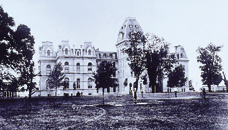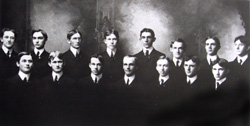
Virtue
Diligence
Brotherly Love
Building Balanced Leaders for the World's Communities
 |
Ryland Hall, Richmond College, 1901 |
Richmond College, where Sigma Phi Epsilon was founded in the early 20th Century, was, at the time, attended by a mere 200 students, and perhaps between a third and a half of this number belonged to five fraternities. Kappa Alpha Order had come there in 1870, Phi Kappa Sigma in 1873, Phi Gamma Delta in 1890, Pi Kappa Alpha in 1891, and Kappa Sigma in 1898. Phi Delta Theta, Sigma Chi, and Sigma Alpha Epsilon also had established chapters there which had expired. The little Baptist college was founded in 1830, and many of its graduates became Baptist ministers.
Most of the national fraternities, as their histories show, have been established simply because they were needed. The hunger for brotherhood was at the bottom of an unrest in young men’s souls. Sigma Phi Epsilon was founded because 12 young collegians hungered for a campus fellowship based on ideals that neither the college community nor the fraternity system at the time could offer. Sigma Phi Epsilon was needed. It was founded, moreover, because the leadership which is required for such a project asserted itself in fortunate ways.
 |
Carter Jenkens, |
Carter Ashton Jenkens, the 18-year-old son of a minister, had been a student at Rutgers University, New Jersey, where he had joined Chi Phi Fraternity. When he transferred to Richmond College in the Fall of 1900, he sought companions to take the place of the Chi Phi brothers he had left behind at Rutgers. During the course of the term, he found five men who had already been drawn into a bond of an informal fellowship, and he urged them to join him in applying for a charter of Chi Phi at Richmond College. They agreed, and the request for charter was forwarded to Chi Phi only to meet with refusal because Chi Phi felt that Richmond College, as any college with less than 300 students, was too small for the establishment of a Chi Phi chapter.
Wanting to maintain their fellowship, the six men, Jenkens, William Carter, Thomas Wright, William Phillips, Benjamin Gaw, and William Wallace, decided to form their own local fraternity.
Of the six, Jenkens was the only one who really knew what a fraternity was, so the task of drawing the plans for the new fraternity fell to him.
Early records described young Jenkens' thorough search for a philosophy upon which a new college fraternity could be built. He discovered in the Bible what he called "the greatest truth the world has ever known."
While in the formative stages, the six original found six others who were also searching for a campus fellowship that neither the college campus nor the existing fraternity system could offer. The six new members were Lucian Cox, Richard Owens, Edgar Allen, Robert McFarland, Franklin Kerfoot, and Thomas McCaul.
The 12 met one day in October, 1901, in Gaw and Wallace’s room on the third floor of Ryland Hall to discuss organization of the Fraternity they would call "Sigma Phi." The exact date of this meeting is not known, and if any minutes were kept, they have been lost. However, the meeting was probably held before the middle of the month, because the 12 founders are named as members on November 1, 1901, in the first printed roster of the Fraternity. Jenkens is listed as the first member.
 |
Fifteen of Sigma Phi Epsilon's |
A committee of Jenkens, Gaw, and Phillips was appointed to discuss plans with the administration of the college. These men met with a faculty committee, where they requested to present their case. The fraternity committee requested that the new group explain:
The fraternity committee answered: "This fraternity will be different, it will be based on the love of God and the principle of peace through brotherhood. The number of members will be increased from the undergraduate classes. We will change the name to Sigma Phi Epsilon." Though the discussion lasted some time, the faculty committee was friendly, and permission was granted for the organization of the new fraternity to proceed, provided full responsibility for the consequences would rest on the group of 12 students.
Immediately at the close of the conference with the faculty committee, the fraternity committee rushed to Jenkens’ room to borrow Hugh Carter’s Greek-English Lexicon; convinced themselves that Epsilon had a desirable meaning, and then telegraphed jeweler Eaton in Goldsboro, North Carolina, to add an Ε at the point of each of the 12 badges which were manufactured and ready for shipment. Before the job of adding an E on the badges was complete, eight other students were invited to join SigEp. The purchase order was then increased to 20 badges at $8 each, with the initials of each man engraved on the back of his badge.
These 20 original heart-shaped badges were of yellow gold, with alternating rubies and garnets around the edge of the heart, with the Greek characters ΣΦ and the skull and crossbones in gold and black enamel in the center and a black Ε in gold at the point. (William Hugh Carter’s and Thomas V. "Uncle Tom" McCaul's original badges are on display at Zollinger House.)
Founder Lucian Cox reflected on the "brotherhood that had inspired him and his Brothers" when he wrote in the Sigma Phi Epsilon Journal, Vol. 1 No. 1, March, 1904:
"As a member of an ideal fraternity, the resources of every member of that body are my resources, the product of their lives is my daily life. The Fraternity is a common storehouse for experience, moral rectitude, and spirituality; the larger and purer the contribution of the individual the greater the resources of each member."
Five men were invited to join before Christmas and became members in January, 1902. The last three of the first group of 20 joined on February 1, 1902, and another in March.